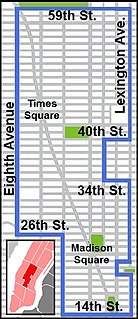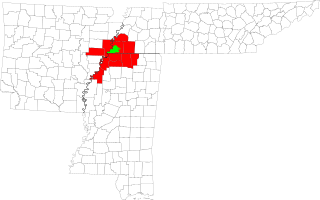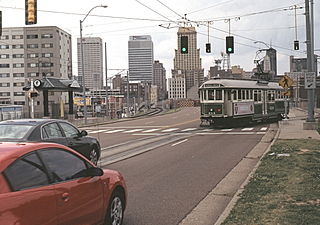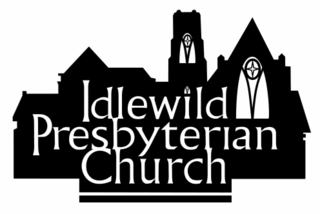
Carnegie Hill is a neighborhood within the Upper East Side, in the borough of Manhattan in New York City. Its boundaries are 86th Street on the south, Fifth Avenue on the west, with a northern boundary at 98th Street that continues just past Park Avenue and turns south to 96th Street and proceeds east up to, but not including, Third Avenue. The neighborhood is part of Manhattan Community District 8.

Cooper-Young is an eclectic neighborhood and historic district in the Midtown section of Memphis, Tennessee, named for the intersection of Cooper Street and Young Avenue. The entrance to the neighborhood is marked by the Cooper-Young Trestle, a 150-foot (46 m) long steel sculpture which depicts homes and businesses found in the neighborhood. Created by metal artist Jill Turman, the sculpture was dedicated in 2000, and has become a source of community pride and identity. In 2012, Cooper-Young was listed on the American Planning Association's 10 Great Neighborhoods in the U.S list.

Manhattan Community Board 5 is a New York City community board, part of the local government apparatus of the city, with the responsibility for the neighborhoods of Midtown, Times Square, most of the Theater District, the Diamond District, the Garment District, Herald Square, Koreatown, NoMad, Murray Hill and the Flatiron District, all in the borough of Manhattan. It is bounded by 59th Street on the north, Eighth Avenue, 26th Street, the Avenue of the Americas on the west, 14th Street on the south, and Lexington Avenue on the east, excluding the area from 34th to 40th Streets between Madison and Lexington Avenues, and the area from 20th to 22nd Streets between Park Avenue South and Lexington Avenue/Irving Place.

Central Gardens is a historic Memphis neighborhood in Midtown. It has been named one of North America's best "Old House Neighborhoods."
Interstate 240 (I-240) is a 19.27-mile-long (31.01 km) Auxiliary Interstate Highway in the U.S. state of Tennessee. It forms a loop with its parent I-40 around the eastern neighborhoods of Memphis. It travels from an interchange with I-40 east of downtown to an interchange with I-40, US 79, and Sam Cooper Boulevard in East Memphis, providing access to Memphis International Airport and the eastern neighborhoods. The section in East Memphis around Walnut Grove Road is the busiest interstate in Tennessee, with an AADT of just under 200,000 vehicles. The western leg of I-240 has been approved to be signed as I-69.

The Memphis–Forrest City Combined Statistical Area, TN–MS–AR (CSA) is the commercial and cultural hub of The Mid-South or Ark-Miss-Tenn. The census defined combined statistical area covers ten counties in three states – Tennessee, Mississippi, and Arkansas. As of census 2010 the MSA had a population of 1,324,108. The Forrest City Micropolitan area was added to the Memphis area in 2012 to form the Memphis–Forrest City Combined Statistical area and had a population of 1,369,548 according to census estimates. The greater Mid-South area as a whole has a population of 2.4 million according to 2013 census estimates. This area is covered by Memphis local news channels and includes the Missouri Bootheel, Northeast Arkansas, West Tennessee, and North Mississippi.
The Memphis Medical District is an area which was created to provide a central location for medical care, serving both Memphis and the Mid-South.
East Memphis is a region of Memphis, Tennessee with several defined and informal subdivisions and neighborhoods such as Colonial Acres, White Station-Yates, Sherwood Forest, Normal Station, High Point Terrace, Belle Meade, Normandy Meadows, St. Nick, Pleasant Acres, Balmoral, and Ridgeway. The general boundaries are informal:

Community boards of Manhattan are New York City community boards in the borough of Manhattan, which are the appointed advisory groups of the community districts that advise on land use and zoning, participate in the city budget process, and address service delivery in their district.

Evergreen Historic District is one of the oldest neighborhoods in Memphis, Tennessee.

Memphis, Tennessee has a long history of distinctive contributions to the culture of the American South and beyond. Although it is an important part of the culture of Tennessee, the history, arts, and cuisine of Memphis are more closely associated with the culture of the Deep South than the rest of the state. For example, the city's influence on 20th-century music has had worldwide impact. Memphians have had an important role in founding or establishing several important American music genres, including blues, gospel, rock and roll, and "sharecropper" country music.

Vollintine Hills Historic District is a historic district located in the Midtown area of Memphis, Tennessee, notable for its cohesive collection of 78 post-World War II Minimal Traditional and ranch-style houses built around a former synagogue. "The neighborhood represents the efforts of members of an Orthodox religious group to accommodate their beliefs by developing a synagogue and housing for the congregation within easy walking distance."

Sam Cooper Boulevard is an urban highway in Memphis, Tennessee, United States. The more recent western segment of the road follows a parkway design, the older eastern portion which was proposed and constructed as a segment of Interstate 40 (I-40) is built as a freeway, without at-grade intersections and traffic lights. The western terminus of Sam Cooper Boulevard is at East Parkway North. At the western termination point of the road there is a short concurrency of East Parkway North with U.S. Route 64, U.S. Route 70, and U.S. Route 79. From its western end, Sam Cooper Boulevard continues east for 5.8 miles (9.3 km) to reach its eastern terminus at the Interstate 40/Interstate 240 interchange.

Glenview Historic District is a neighborhood in Memphis, Tennessee that was listed on the National Register of Historic Places as a historic district in 1999. The neighborhood is between South Memphis and Midtown and bounded by the Illinois Central Railroad on the west, Lamar Ave on the east, Southern Ave on the north and South Parkway on the south.

Binghampton is a neighborhood on an edge of Midtown in Memphis, Tennessee. It is named after WH Bingham, an Irish immigrant, hotelier, planter, magistrate, politician and entrepreneur who founded a town to the east and slightly north of Memphis, Tennessee in 1893.

The Memphis Parkway System, locally known as the Parkway System, The Parkways, or simply by their individual names is a system of parkways that formed the original outer beltway around Memphis, Tennessee. They consist of South Parkway, East Parkway, and North Parkway. Designed by George Kessler, the Parkway System connects Martin Luther King Jr. Riverside Park with Overton Park. The system was put on the National Register of Historic Places on July 3, 1989.

The Madison Avenue Line is a line of the Memphis Area Transit Authority trolley system. The trolley line began operating in 2004, and cost $56 million to build. Currently, it operates 2.2 mi (3.5 km) of double track along Madison Avenue with six stops stretching into Midtown Memphis. The line was built to connect the Main Street system to the Medical District just east of Downtown Memphis.

Idlewild Presbyterian Church is a historic church located at 1750 Union Avenue in Midtown Memphis, Tennessee. Idlewild is a part of the Presbyterian Church (USA).








































